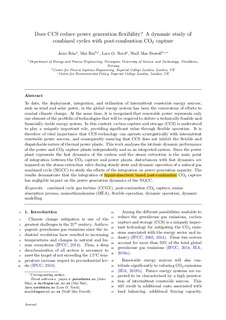| dc.contributor.author | Rúa, Jairo | |
| dc.contributor.author | Bui, Mai | |
| dc.contributor.author | Nord, Lars O. | |
| dc.contributor.author | Mac Dowell, Niall | |
| dc.date.accessioned | 2020-02-26T09:08:18Z | |
| dc.date.available | 2020-02-26T09:08:18Z | |
| dc.date.created | 2020-02-25T12:38:46Z | |
| dc.date.issued | 2020 | |
| dc.identifier.issn | 1750-5836 | |
| dc.identifier.uri | http://hdl.handle.net/11250/2643782 | |
| dc.description.abstract | To date, the deployment, integration, and utilization of intermittent renewable energy sources, such as wind and solar power, in the global energy system has been the cornerstone of efforts to combat climate change. At the same time, it is recognized that renewable power represents only one element of the portfolio of technologies that will be required to deliver a technically feasible and financially viable energy system. In this context, carbon capture and storage (CCS) is understood to play a uniquely important role, providing significant value through flexible operation. It is therefore of vital importance that CCS technology can operate synergistically with intermittent renewable power sources, and consequently ensuring that CCS does not inhibit the flexible and dispatchable nature of thermal power plants. This work analyses the intrinsic dynamic performance of the power and CO2 capture plants independently and as an integrated system. Since the power plant represents the fast dynamics of the system and the steam extraction is the main point of integration between the CO2 capture and power plants, disturbances with fast dynamics are imposed on the steam extraction valve during steady state and dynamic operation of a natural gas combined cycle (NGCC) to study the effects of the integration on power generation capacity. The results demonstrate that the integration of liquid-absorbent based post-combustion CO2 capture has negligible impact on the power generation dynamics of the NGCC. | nb_NO |
| dc.language.iso | eng | nb_NO |
| dc.publisher | Elsevier | nb_NO |
| dc.rights | Attribution-NonCommercial-NoDerivatives 4.0 Internasjonal | * |
| dc.rights.uri | http://creativecommons.org/licenses/by-nc-nd/4.0/deed.no | * |
| dc.title | Does CCS reduce power generation flexibility? A dynamic study of combined cycles with post-combustion CO2 capture | nb_NO |
| dc.type | Journal article | nb_NO |
| dc.type | Peer reviewed | nb_NO |
| dc.description.version | acceptedVersion | nb_NO |
| dc.source.volume | 95 | nb_NO |
| dc.source.journal | International Journal of Greenhouse Gas Control | nb_NO |
| dc.identifier.doi | https://doi.org/10.1016/j.ijggc.2020.102984 | |
| dc.identifier.cristin | 1797292 | |
| dc.description.localcode | © 2020. This is the authors’ accepted and refereed manuscript to the article. Locked until 25.2.2022 due to copyright restrictions. This manuscript version is made available under the CC-BY-NC-ND 4.0 license http://creativecommons.org/licenses/by-nc-nd/4.0/ | nb_NO |
| cristin.unitcode | 194,64,25,0 | |
| cristin.unitname | Institutt for energi- og prosessteknikk | |
| cristin.ispublished | true | |
| cristin.fulltext | original | |
| cristin.fulltext | postprint | |
| cristin.qualitycode | 2 | |

